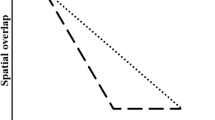Abstract
The utility of the definition of territory proposed by Davies (1978) (individual animals or groups are spaced out more than would be expected from a random occupation of suitable habitats) was tested by applying it to an analysis of spacing behavior in voles,Clethrionomys rufocanus bedfordiae (Thomas). The examination of the Nearest Neighbor Distance and spatial distribution of home range suggested that, by this definition, adult females had territories in both winter and spring, while adult males had them only in winter. Davies' (1978) definition includes not only exculsive spacing, of which the functions are known, but also some kinds of spacing of which the functions are unknown, while the more rigid definition of Burt (1943) (“any defended area”) excludes the idea of spacing behavior without observation of the maintenance mechanism, even though the functions are known. InC. rufocanus bedfordiae, it seems more practical to consider exclusive spacing as territory, especially when the functions of their spacing behavior have some points in common with the facts already ascertained as functions of territoriality.
Similar content being viewed by others
References
Abe, H. 1976 Population structure and reproductive activity ofClethrionomys rufocanus bedfordiae (Thomas) in a wind shelter-belt of the Ishikari Plain Hokkaido.J. Mamml. Soc. Jap. 7: 17–30. (In Japanese with English summary)
Brown, J. L. & G. H. Orians 1970 Spacing patterns in mobile animals.A. Rev. Ecol. Syst. 1: 239–262.
Bujalska, G. 1970 Reproduction stabilizing elements in an island population ofClethrionomys glareolus Schreber, 1780).Acta theriol. 15: 381–412.
Bujalska, G. 1973 The role of spacing behavior among females in the regulation of reproduction in the bank vole.J. Repro. Fertil. suppl. 19: 465–474.
Burt, W. H. 1943 Territoriality and home range concepts as applied to mammals.J. Mammal. 24: 346–352.
Davies, N. B. 1978 Ecological questions about territorial behaviour. In: J. R. Krebs & N. B. Davies (eds.)Behavioural ecology—an evolutionary approach. pp. 317–350. Blackwell Scientific Publications.
Davies, N. B. & A. I. Houston 1984 Territory economics. In: J. R. Krebs & N. B. Davies (eds.)Behavioural ecology—an evolutionary approach (second edition). pp. 148–169. Blackwell Scientific Publications.
Ellenbroek, F. J. M. 1980 Interspecific competition in the shrew,Sorex araneus andS. minutus (Soricidae Insectivora): a population study of the Irish pygmy shrew.J. Zool. Lond. 192: 119–136.
Fitzgerald R. W. & D. M. Madison 1983 Social organization of a free-ranging population of pine voles,Microtus pinetorum.Behav. Ecol. Sociobiol. 13: 183–187.
Getz, L. L. 1961 Home ranges, territoriality, and movement of the meadow vole.J. Mammal. 42: 24–36.
Hawes, M. L. 1977 Home range, territoriality, and ecological separation in sympatric shrews.Sorex vagrans andSorex obscurus.J. Mammal. 58: 354–367.
Hayne, D. W. 1949 Calculation of size of home range.J. Mammal. 30: 1–18.
Hinde, R. A. 1956 The biological significance of the territories of birds.Ibis 98: 340–369.
Itô, Y. 1980 Comparative ecology. J. Kikkawa (ed. and translated) Cambridge University Press, 436pp.
Jewell, P. A. 1966 The concept of home range in mammals.Symp. Zool. Soc. Lond. 18: 85–109.
Kalela, O. 1957 Regulation of reproduction rate in subaretic population of the voleClethrionomys rufocanus (Sund.).Annal. Acad. Sci. Fenn., Ser. A. IV Biol. 34: 1–60.
Kaufman, J. H. 1983 On the definitions and functions of dominance and territoriality.Biol. Rev. 58: 1–20.
Krebs, J. R. 1971 Territory and breeding density in the great tit,Parus major L.Ecology 52: 2–22.
Lundberg, A. 1981 Population ecology of the ural owlStrix uralensis in central Sweden.Ornis Scand. 12: 111–119.
Madison, D. M. 1980 Space use and social structure in meadow voles,Microtus pennsylvanicus.Behav. Ecol. Sociobiol. 7: 65–71.
Metzgar, L. H. & R. Hill 1971 The measurement of dispersion in small mammal populations.J. Mammal. 52: 12–20.
Michielsen, C. N. 1966 Intraspecific and interspecific competition in the shrews,Sorex minutus andS. araneus.Arch. néerl. Zool. 17: 73–174.
Morse, D. H. 1980 Behavioral mechanism in ecology. Harvard University Press, 383pp.
Myllymäki, A. 1977 Intraspecific competition and home range dynamics in the field voleMicrotus argestis.Oikos 29: 553–569.
Noble, G. K. 1939 The role of dominance in the social life of birds.Auk 56: 263–273.
Orians, G. H. 1961 The ecology of blackbird (Agelaius) social systems.Ecol. Monogr. 31: 285–312.
Pernetta, J. C. 1977 Population ecology of British shrews in grassland.Acta theriol. 22: 279–296.
Pitelka, F. A. 1959 Numbers, breeding schedule, and territoriality in pectoral sandpipers in Northern Alaska,Condor 61: 233–264.
Platt, W. J. 1976 The social organization and territoriality of short-tailed shrew (Blarina brevicauda) populations in oldfield habitats.Anim. Behav. 24: 305–318.
Saitoh, T. 1981 Control of females maturation in high density population of the red-backed vole,Clethrionomys rufocanus bedfordiae.J. Anim. Ecol. 50: 79–87.
Saitoh, T. 1983 Survival rate and mobility in an enclosed population of red-backed vole,Clethrionomys rufocanus bedfordiae.Acta theriol. 28: 301–315.
Schoener, T. W. 1968 Size of feeding territories among birds.Ecology 49: 123–141.
Tanaka, R. 1953 Home range and territories inClethrionomys population on a peat-bog grassland in Hokkaido.Bull. Kochi Women's College 2: 10–20.
Viitala, J. 1977 Social organization in cyclic subarctic population of the volesClethrionomys rufocanus (Sund.) andMicrotus agrestis (L.).Ann. Zool. Fennici. 14: 53–93.
Watson, A. & D. Jenkins 1968 Experiments on population control by territorial behavior in red grouse.J. Anim. Ecol. 37: 595–614.
Webster, A. B. & J. Brooks 1981 Social behavior ofMicrotus pennsylvanicus in relation to seasonal changes in demography.J. Mammal. 62: 738–751.
Wilson, E. O. 1975 Sociobiology. The Belknap Press of Harvard University Press, 697 pp.
Author information
Authors and Affiliations
About this article
Cite this article
Saitoh, T. Practical definition of territory and its application to the spatial distribution of voles. J. Ethol. 3, 143–149 (1985). https://doi.org/10.1007/BF02350305
Received:
Accepted:
Issue Date:
DOI: https://doi.org/10.1007/BF02350305




